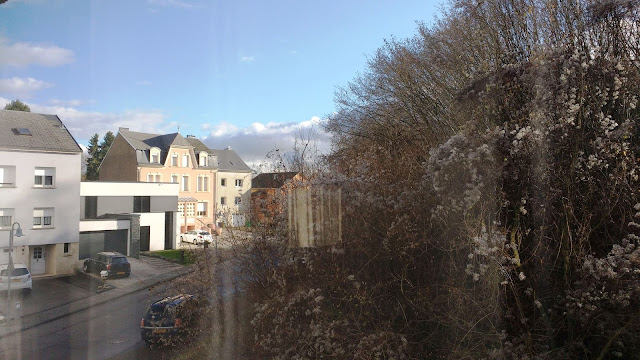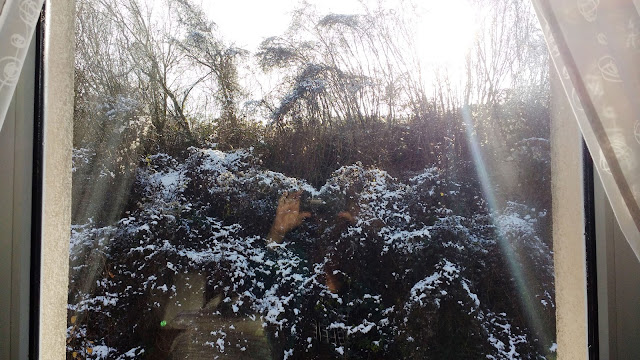Living in Luxembourg means multilingualism. You speak certain
language/s with certain people at certain places. During one day you can speak
three or four different languages. It´s like that. It´s amazing. It´s real. Multilingual interviews start with Inês Vasconcelos, a vegan, Portuguese young woman living just
across the border and working in the hub of Kirchberg. She speaks Portuguese,
Spanish, French and English and she is always eager to learn new languages.

1. Penses-toi que l'alimentation végane revient
plus cher qu'à votre alimentation actuelle? Non, je ne pense pas car après être végane pendant 6 mois j’ai remarqué que
je ne dépense pas autant d’argent comme avant. En fait, l’alimentation végane
est basée sur les aliments qui ne sont pas industrialisées, donc ils n’ont pas
des addictifs et Chimiques. Si on n’achète pas de gâteaux, des bonbons, des
biscuits, des frites, chocolats et une infinité des produits qui l’industrie
alimentaire nous fait croire que l’on a besoin, la vérité c’est qu’on va sauver
de l’argent. Car les produits dans leur état naturel comme les légumes n’ont
pas un gros coût de production.
2. A Vegan in
Kirchberg... What do you eat for lunch? Do you have any suggestions? Most of the time I cook the day
before so that I can bring my own food to work, which is healthier and another
way to save money. When I don’t have something prepared I go to Exki in Auchan. I’m sure I’m not the only vegan in Kirchberg, since they
have vegan soups and other dishes which disappear quite fast if I don’t go
there before noon. In addition, there is Dany and David’s just 5 minutes away
from my workplace. There you can find a great variety of vegan sandwiches,
salads and even deserts. Then, when I go for lunch with my
colleagues from the office and they plan to eat somewhere else, I always speak
with the waitress and ask for rice or pasta with vegetables. People now start
to be more aware of what is it to be vegan and it’s not as difficult as before
to explain what I can eat or not.

3. ¿Qué pasa con los productos lácteos y los
huevos? Como los
productos lácteos y los huevos son de origen animal no están incluidos en la
dieta vegana. Quizás las personas piensen que al comer huevos no perjudican las
gallinas porque estas siguen vivas (aunque utilicemos sus huevos en nuestra
alimentación). Pero la verdad es que por detrás de las imágenes de gallinas
felices y libres en la publicidad de las cajas de huevos, hay toda una
industria donde las gallinas ponedoras son esclavizadas, mutiladas y medicadas
para producir al máximo. De hecho,
todo esto lleva a una muerte prematura con una vida media de 2 años que podría
ser de entre 7 a 8 años. Además,
muchísimos estudios comprueban que los huevos no son sanos para nuestra salud
por el alto nivel de colesterol, la posibilidad de contagio con salmonela y
otros riesgos. En lo que dice respecto a la leche de vaca, ésta es una de las
mayores causas de osteoporosis porque actúa como un ácido que va lentamente
destruyendo nuestros huesos que liberan calcio para combatir ese proceso.
Asimismo, está llena de hormonas de crecimiento, antibióticos y otros
adictivos. Los productos lácteos están entonces excluidos
de nuestra dieta. Es probable que mucha gente lo ignore pero, para tener leche,
las vacas deben dar a luz a los becerros, luego tienen que ser preñadas a la
fuerza. La industria de láctea le da el nombre de “inseminación artificial
“para que no parezca tan malo. Luego el becerro es sacado a la fuerza de su
madre para que nosotros bebamos su leche en su lugar. El acto de separar al
becerro de su madre le da mucho estrés a la progenitora, resultando en
descargas de insulina que van directamente a la leche que más tarde nosotros
consumimos. El becerro aun bebé es mantenido en una caja
muy pequeña donde se encuentra inmóvil y alimentado sobre todo por líquidos
para que luego su carne muy delgada sea vendida y rentable. En el caso de que se estén preguntando de donde
sacamos el calcio si no tomamos productos lácteos, es muy sencillo… Lo
encontramos en gran abundancia en las semillas de chía y sésamo por ejemplo.
También en los higos secos, judías verdes, zumo de naranja, brócoli, kiwi,
pepino, espinaca, algas, frutos secos y otras verduras.
 |
| Como alternativa para tomar con el café, cappuccino, yogures y hasta helados, se puede substituir con leches vegetales como de almendras, soja, arroz, coco, etc. A mí me gusta especialmente la de avena. En la cocina, para utilizar en vez de huevo se pude utilizar harina de lino, yogur, plátano, puré de frutas, semillas de agar y de linaza, crema de cacahuetes y claro, el sustituto comercial del huevo. |

4. Os veganos não têm
receio de contrair anemia, ou carência de cálcio, etc.? De onde retiras a tua
proteína? Ao principio todos os veganos têm esse medo,
mas ao informarem-se bem de como se alimentarem, logo percebem que nao correm
esse risco. Como eu referi acima, o calcio pode ser encontrado numa grande
variedade de alimentos como verduras verdes, sementes e frutos secos. A anemia
também não é um risco visto que uma alimentacão com grande variedade
leguminosas e legumes aporta todo o ferro necessário com alimentos como
lentilhas, grao de bico, feijao, massas, cereais integrais, soja e tofu etc. A
proteína está presente em quinoa, bulgor, folhas verdes, ervilhas, abacate,
chia, nozes, tempeh, trigo, grão de bico, couve flor, cogumelos, tomate etc, e
nos alimentos referidos anteriormente e muitos outros. Existem ainda
suplementos de vitaminas que podem compensar carencias que até uma pessoa que
coma carne poderia vir a ter algum dia.
 |
| You can follow Inês on Instagram: ines.vasconcelos.9 |
5. Connaisses-toi beaucoup des personnes véganes
dans votre entourage? Pour le moment je connais 4 personnes dans mon entourage, mas sur internet
je connais beaucoup plus et on exchange nos expériences, recettes et
motivations.
6. Why did you become
a vegan? I did it for the animals, for
myself and for the planet. I was vegetarian already for a while and I did the
switch because I was already sick of all the cruelty against animals. I have
realized that the food industry is lying to us and that animals are kept in
really bad conditions from the moment they are born until they die just to
serve our requirements and food in our plates. Plus, I got to understand that
they have feelings too and the sense of family as we do. They also grieve their
loved ones and miss their children as much as we do, and if people don’t want
to see that, it is because they choose to be blind. By going vegan we help
fighting against deforestation, the war for resources, the climate change,
since dairy industry is the most polluting one. And what about the hunger in
the world? Can someone explain to me why we are able to feed thousands and
thousands of livestock and we are not able to stop the hunger and help children
starving around the world? Well, because that’s not profitable as selling meat
and dairy products. Finally, by going vegan we can
reduce the symptoms of heart diseases, diabetes, asthma and many other health
issues. I’m asthmatic and for the last month I didn’t need to take my
medication, I think that’s already a good reason enough. Besides, I lost weight
and I’m still eating all the time.

7. ¿Cómo reemplazas la ingesta de carne para
tener una buena salud? Reemplazo la ingesta de carne con alimentos
como seitán, tofu, soja, lentejas, berenjenas, setas, brócolis, espinacas,
judías, nueces y siempre intento comer arroz y pastas integrales porque tienen
más nutrientes.
8. Por que é que os veganos têm restriçoes em relação ao uso de cosméticos? Porque a maioria dos cosméticos e productos de
higiene são testados em animais tais como coelhos, insectos e ratos de
laboratorio. E em muitos casos um simples champô pode ter algum producto de
origem animal na sua producão. Uma vez que ser vegano é ser contra qualquer
tipo de exploracão animal e proteger os que não se podem proteger a eles
mesmos, os veganos sao contra isso. Felizmente, hoje em dia no mercado já se
encontra uma grande variedade de productos disponíveis que sao chamados de
“cruelty free” e as grandes marcas começam a procurar alternativas na hora de
testar os seus productos.

9. Quels sont les ingrédients interdits pour la
cosméto végan? Les ingrédients interdits son ceux d’origine animal: extraits animales
comme la laine du mouton, le lait de vache, de chèvre, ou le miel et cire des
abeilles, la lanoline (une graisse extraite de la laine du mouton), gélatine,
extraits de poisson, huile de foie de requin, crustacés, collagène des poissons
entre autres.
10. Are you a perfect
vegan? There’s no such thing as perfect
vegan. It is important that we avoid as much cruelty against other living
beings as we can and living a life without exploiting animals. I have the
conscience that I’m no superior to any other species in the earth and I feel
more connected to the world now. Even if one day we realise that we ate or use
something that contained animal products on it, we shall not give up since we
are doing our best and we are on the right path.
11. ¿Por qué debemos ser veganos?
Por todas las razones que dije antes, por los
animales, por nuestra salud, por el mundo.
12. É difícil ser vegana? A única razão pela qual é difícil ser vagana é
o facto das pessoas te verem como uma extraterrestre quando a única coisa que
estás a fazer é tentar salvar o mundo da poluição e salvar vidas
inocentes. Não ha necessidade de comer
animais para ser saudável. Hoje em dia ha cada vez mais produtos disponíveis,
tais como queijo, leite, bolachas, pão, etc. sem origem em productos animais.
Algum dia as pessoas vão entender que o ser humano não é superior ás outras
especies e que estamos todos juntos neste mundo e é nosso dever tomar conta
dele. Aconselho vivamente a quem se interessar pelo tema a ver documentarios
como:
Cowspiracy, Earthlings, Forks over
knives e
what the health.
Inês finished the interview by thanking
me: “Obrigado Corina por poder partilhar isto contigo e pela oportunidade de
esclarecer as pessoas sobre um tema cada vez mais recurrente mas do qual tão
pouco ainda se sabe.”
I am also really thankful
to this smart and energetic person who has taken the time to answer in depth
all these questions.
I hope, my dear reader, that you have enjoyed reading her
multilingual answers and that you learnt about being vegan. Maybe now you
even consider changing your diet.
Are you looking forward to my next multilingual interview?
Stay tuned!
Corina Moscovich






















































